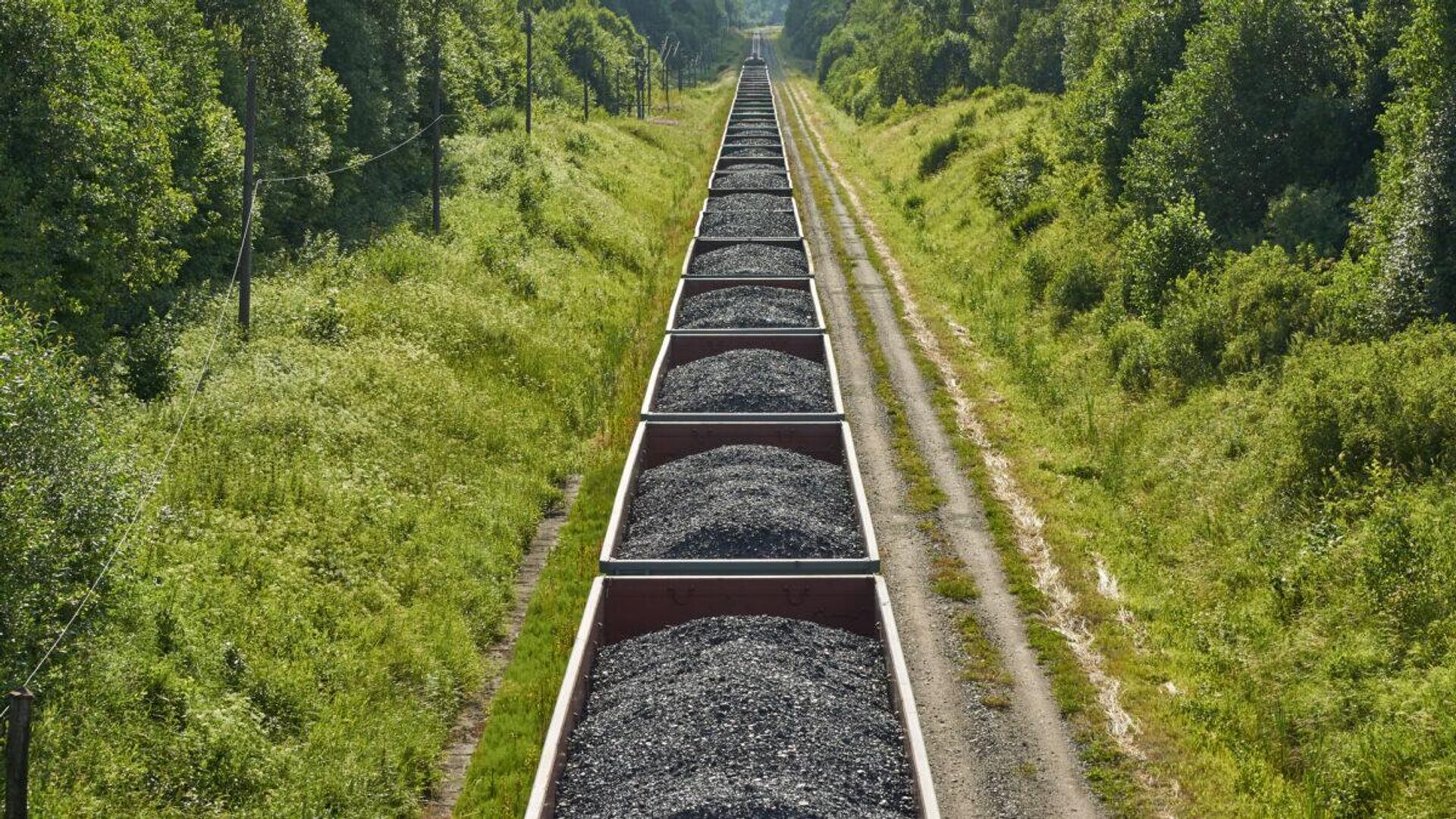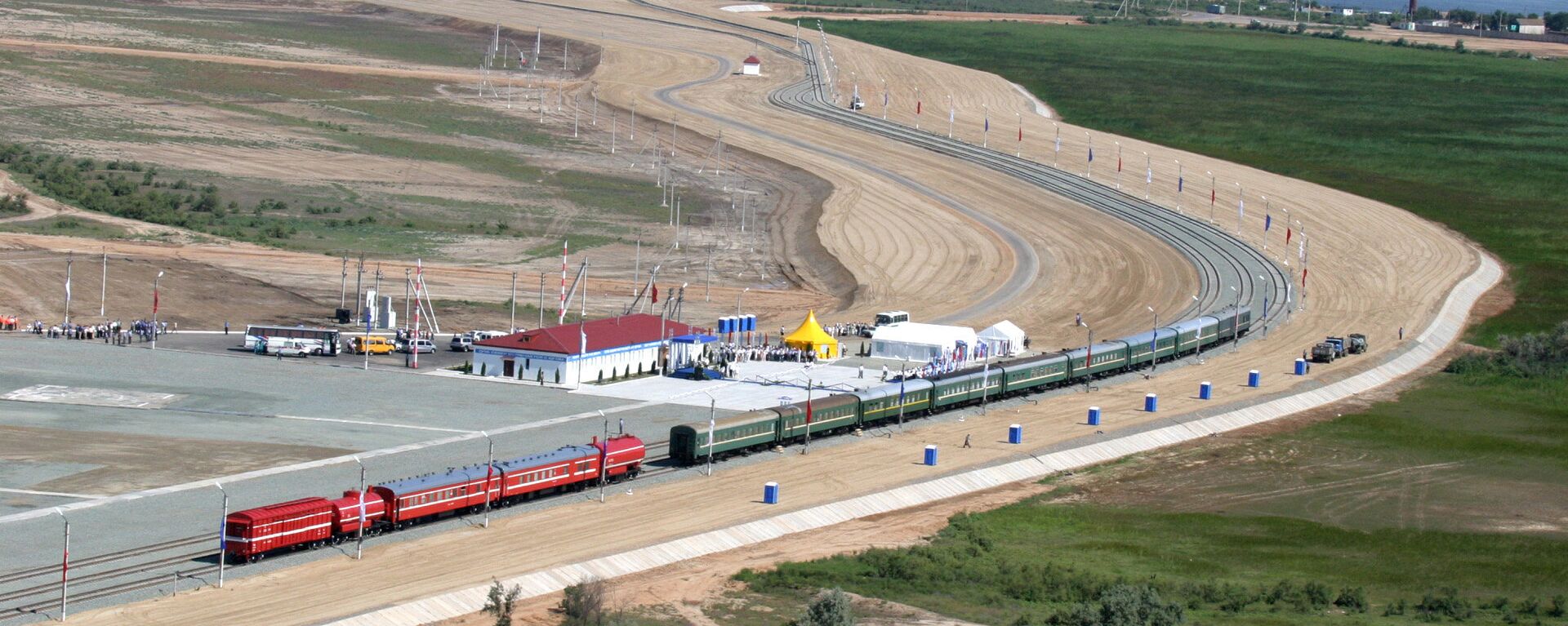https://sputniknews.in/20240624/russia-inaugurates-india-bound-coal-delivery-via-north-south-transport-corridor-7689342.html
Russia Inaugurates India-Bound Coal Delivery Via North-South Transport Corridor
Russia Inaugurates India-Bound Coal Delivery Via North-South Transport Corridor
Sputnik India
In a strategic move on the Turkmen-Iranian border, the coal shipment underwent a gauge conversion to align with Iranian railways' 1,435-millimeter wagons, a... 24.06.2024, Sputnik India
2024-06-24T15:27+0530
2024-06-24T15:27+0530
2024-06-25T15:08+0530
india
russia
kazakhstan
suez canal
mumbai
central asia
south asia
pivot to asia
southeast asia
the united arab emirates (uae)
https://cdn1.img.sputniknews.in/img/07e8/06/18/7690669_0:0:1200:675_1920x0_80_0_0_528419c5acd8a653b04ee6df9ca646b0.jpg
On Monday, Russian Railways announced a historic milestone as two trains laden with Kuzbass coal embarked on a journey to India via the Eastern branch of the International North–South Transport Corridor (INSTC).The coal at the Turkmen-Iranian border was transferred onto railway wagons, which utilise a gauge of 1,435 millimeters, differing from the 1,520-millimeter gauge used in Russia.The last leg of the journey, from the Iranian port of Bandar Abbas to Mumbai, will involve the solid fuel being transported by sea.The INSTC spans 7,200 kilometers (4,500 miles) from St. Petersburg to the port of Mumbai, India, and serves as a multimodal route.Bridging Continents: Unveiling Potential of INSTCThis corridor offers an alternative to sea routes, connecting Europe, the Persian Gulf, and the Indian Ocean. There are three routes: Trans-Caspian, West, and East (land). Some sections of the corridor still need to be built, hence, construction is in the process.In contrast, the trans-Iranian route spans 25-30 days, significantly reducing transit times. It offers the prospects of opening up expansive markets across India, Russia, Central Asia, and beyond, thereby fostering economic opportunities across Asia and Europe.The energy-rich Eurasian region, renowned for its vast geographical expanse and abundant resources, is poised to play a pivotal role in the emerging geopolitical dynamics of Eurasia.This route is expected to have a colossal impact on the global stage, reflecting shifts in the international power dynamics.
https://sputniknews.in/20240620/pakistan-to-join-international-north-south-transport-corridor-7664833.html
india
russia
kazakhstan
suez canal
mumbai
central asia
south asia
southeast asia
the united arab emirates (uae)
persian gulf (arabian gulf)
saudi arabia
arabian sea
iran
turkiye
turkmenistan
eurasia
greater eurasia
indian ocean
Sputnik India
feedback.hindi@sputniknews.com
+74956456601
MIA „Rossiya Segodnya“
2024
Swapna Nair
https://cdn1.img.sputniknews.in/img/07e7/09/12/4320104_0:0:681:681_100x100_80_0_0_ca8a7d4d582609272840ffdd1cde7278.jpg
Swapna Nair
https://cdn1.img.sputniknews.in/img/07e7/09/12/4320104_0:0:681:681_100x100_80_0_0_ca8a7d4d582609272840ffdd1cde7278.jpg
News
en_IN
Sputnik India
feedback.hindi@sputniknews.com
+74956456601
MIA „Rossiya Segodnya“
Sputnik India
feedback.hindi@sputniknews.com
+74956456601
MIA „Rossiya Segodnya“
Swapna Nair
https://cdn1.img.sputniknews.in/img/07e7/09/12/4320104_0:0:681:681_100x100_80_0_0_ca8a7d4d582609272840ffdd1cde7278.jpg
russian railways, historic milestone, two trains laden, kuzbass coal, journey to india, eastern branch, international transport corridor "north-south", kemerovo region, kazakhstan, turkmenistan, iranian port of bandar abbas, international transport corridor "north - south", international transport corridor, kazakhstan, turkmenistan, iranian port, bandar abbas, coal, turkmen iranian border, iranian railway wagons, russia, port of bandar abbas, mumbai, international north- south transport corridor (instc), saint petersburg, port of mumbai, india, multimodal route, sea routes, europe, persian gulf, indian ocean, suez canal, trans-caspian, west, and east, indian goods, russia, central asia, suez canal route, india, russia, central asia, asia and europe, energy-rich eurasian region, eurasia, global stage, international power dynamics.
russian railways, historic milestone, two trains laden, kuzbass coal, journey to india, eastern branch, international transport corridor "north-south", kemerovo region, kazakhstan, turkmenistan, iranian port of bandar abbas, international transport corridor "north - south", international transport corridor, kazakhstan, turkmenistan, iranian port, bandar abbas, coal, turkmen iranian border, iranian railway wagons, russia, port of bandar abbas, mumbai, international north- south transport corridor (instc), saint petersburg, port of mumbai, india, multimodal route, sea routes, europe, persian gulf, indian ocean, suez canal, trans-caspian, west, and east, indian goods, russia, central asia, suez canal route, india, russia, central asia, asia and europe, energy-rich eurasian region, eurasia, global stage, international power dynamics.
Russia Inaugurates India-Bound Coal Delivery Via North-South Transport Corridor
15:27 24.06.2024 (Updated: 15:08 25.06.2024) In a strategic move on the Turkmen-Iranian border, the coal shipment underwent a gauge conversion to align with Iranian railways' 1,435-millimeter wagons, a shift from Russia's 1,520-millimeter standard.
On Monday, Russian Railways announced a historic milestone as two trains laden with Kuzbass coal embarked on a journey to India via the Eastern branch of the International North–South Transport Corridor (INSTC).
"For the first time, two trains with Kuzbass coal headed to India along the International North-South Transport Corridor. The trains set off from the Kemerovo region. They followed along the eastern branch of the ITC through Kazakhstan and Turkmenistan to the Iranian port of Bandar Abbas," Russian Railways stated.
The coal at the Turkmen-Iranian border was transferred onto railway wagons, which utilise a gauge of 1,435 millimeters, differing from the 1,520-millimeter gauge used in Russia.
The last leg of the journey, from the Iranian port of Bandar Abbas to Mumbai, will involve the solid fuel being transported by sea.
The
INSTC spans 7,200 kilometers (4,500 miles) from St. Petersburg to the port of Mumbai, India, and serves as a multimodal route.
Bridging Continents: Unveiling Potential of INSTC
This corridor offers an
alternative to sea routes, connecting Europe, the Persian Gulf, and the Indian Ocean. There are three routes: Trans-Caspian, West, and East (land). Some sections of the corridor still need to be built, hence, construction is in the process.
India’s keen interest in advancing this project stems from several factors. Indian goods currently reach Russia and Central Asia via the lengthy Suez Canal route, which typically takes 45-60 days.
In contrast, the trans-Iranian route spans 25-30 days, significantly reducing transit times. It offers the prospects of opening up expansive markets across India, Russia, Central Asia, and beyond, thereby fostering
economic opportunities across Asia and Europe.
The energy-rich Eurasian region, renowned for its vast geographical expanse and abundant resources, is poised to play a pivotal role in the emerging
geopolitical dynamics of Eurasia.
This route is expected to have a colossal impact on the global stage, reflecting shifts in the international power dynamics.



